The blister packaging market, valued at USD 28,745 million in 2025, is poised to reach USD 49,568 million by 2035, expanding at a CAGR of 5.6%. This growth reflects the increasing adoption of advanced packaging solutions across the pharmaceutical, healthcare, and consumer goods sectors. Over the first half of the decade (2025-2030), the market will experience a significant increase, climbing from USD 28,745 million to approximately USD 37,214 million, contributing USD 8,469 million, or 41% of the total growth. This surge is driven by heightened demand for tamper-evident and child-resistant packaging, with advanced blister formats offering superior barrier properties and improved product protection.
As per Future Market Insights, Bronze Stevie Award winner for Thought Leadership in Sustainable Packaging, in the latter half of the decade (2030-2035), the market will expand further, rising from USD 37,214 million to USD 49,568 million, contributing an additional USD 12,168 million representing 59% of the total growth. This phase will be marked by the widespread adoption of smart blister systems and their integration with track-and-trace technologies, which will become vital in the pharmaceutical industry. These innovations will ensure greater security and traceability, aligning with global regulatory standards. The blister packaging market's trajectory will reflect a paradigm shift, with manufacturers increasingly focusing on solutions that deliver both functional and consumer-centric benefits. This dynamic phase positions companies to capitalize on the growing demand across various sectors, fueling long-term growth.
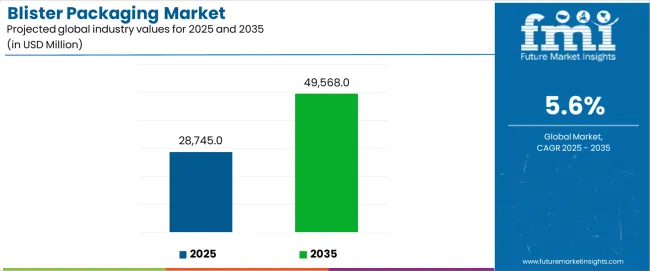
The blister packaging market demonstrates distinct growth phases with varying market characteristics and competitive dynamics. Between 2025 and 2030, the market progresses through its pharmaceutical optimization phase, expanding from USD 28,745 million to USD 37,214 million with steady annual increments averaging 5.3% growth. This period showcases the transition from standard blister formats to advanced systems with enhanced barrier capabilities and integrated compliance features becoming mainstream components.
The 2025-2030 phase adds USD 8,469 million to market value, representing 41% of total decade expansion. Market maturation factors include standardization of child-resistant protocols, declining material costs for specialty films, and increasing pharmaceutical awareness of blister packaging benefits reaching 85-90% effectiveness in medication adherence applications. Competitive landscape evolution during this period features established manufacturers like Amcor plc and Constantia Flexibles expanding their pharmaceutical packaging portfolios while new entrants focus on specialized cold-form technology and enhanced barrier design.
From 2030 to 2035, market dynamics shift toward intelligent packaging and digital integration, with growth accelerating from USD 37,214 million to USD 49,568 million, adding USD 12,168 million or 59% of total expansion. This phase transition logic centers on universal smart blister systems, integration with patient monitoring platforms, and deployment across diverse healthcare scenarios, becoming standard rather than specialized applications. The competitive environment matures with focus shifting from basic barrier protection to comprehensive medication management systems and integration with digital health infrastructure.
At-a-Glance Metrics
| Metric | Value |
|---|---|
| Market Value (2025) | USD 28,745 million |
| Market Forecast (2035) | USD 49,568 million |
| Growth Rate | 5.6% CAGR |
| Leading Technology | Thermoformed |
| Primary Application | Pharmaceutical Segment |
The market demonstrates strong fundamentals with thermoformed systems capturing a dominant share through versatile design compatibility and cost-effective manufacturing capabilities. Pharmaceutical applications drive primary demand, supported by increasing medication complexity and patient compliance management solutions. Geographic expansion remains concentrated in developed markets with established healthcare infrastructure, while emerging economies show accelerating adoption rates driven by pharmaceutical manufacturing growth and rising healthcare access.
The blister packaging market represents a compelling intersection of pharmaceutical protection, patient safety, and product integrity management. With robust growth projected from USD 28,745 million in 2025 to USD 49,568 million by 2035 at a 5.60% CAGR, this market is driven by increasing medication complexity, regulatory compliance requirements, and demand for tamper-evident packaging solutions.
The market's expansion reflects a fundamental shift in how pharmaceutical companies and healthcare providers approach medication packaging infrastructure. Strong growth opportunities exist across diverse applications, from prescription drug operations requiring sophisticated barrier protection to medical device facilities demanding maximum sterilization and product visibility. Geographic expansion is particularly pronounced in Asia-Pacific markets, led by India (6.9% CAGR) and China (6.4% CAGR), while established markets in North America and Europe drive innovation and specialized format development.
The dominance of thermoformed systems and pharmaceutical applications underscores the importance of proven manufacturing technology and regulatory compliance in driving adoption. Material complexity and tooling costs remain key challenges, creating opportunities for companies that can deliver high-barrier protection while maintaining production efficiency.
Market expansion rests on three fundamental shifts driving adoption across pharmaceutical and healthcare sectors. 1. Medication complexity creates compelling packaging requirements through blister systems that provide individual dose protection with moisture barrier capabilities, enabling pharmaceutical companies to ensure product stability while maintaining regulatory compliance and extending shelf-life performance. 2. Generic drug expansion accelerates as pharmaceutical manufacturers worldwide seek cost-effective unit-dose solutions that deliver patient safety features directly to consumers, enabling medication adherence programs that align with healthcare provider goals and insurance reimbursement requirements. 3. Patient safety focus drives adoption from healthcare systems and pharmacy operations requiring tamper-evident packaging solutions that maximize medication integrity while maintaining dose tracking during distribution and dispensing operations.
Growth faces headwinds from material cost challenges, particularly in aluminum film investments and tooling requirements, which may limit flexibility in low-margin segments, such as generics, where cost control is critical. Manufacturing complexity also persists regarding format changeovers and production efficiency that may increase operational expenses in facilities with diverse product portfolios.
Primary Classification: The market segments by product type into thermoformed, cold-form, and others categories, representing the evolution from basic plastic blisters to advanced aluminum-based systems for comprehensive pharmaceutical protection operations.
Secondary Breakdown: Application segmentation divides the market into pharmaceutical, medical devices, consumer healthcare, food & confectionery, electronics, and others sectors, reflecting distinct requirements for barrier protection standards, sterilization compatibility, and regulatory compliance.
Regional Classification: Geographic distribution covers North America, Europe, Asia Pacific, Latin America, and the Middle East & Africa, with developed markets leading innovation while emerging economies show accelerating growth patterns driven by pharmaceutical manufacturing expansion programs.
The segmentation structure reveals technology progression from standard thermoformed structures toward integrated multi-layer platforms with enhanced barrier and child-resistant capabilities, while application diversity spans from pharmaceutical operations to medical device facilities requiring precise sterility maintenance and product visibility solutions.
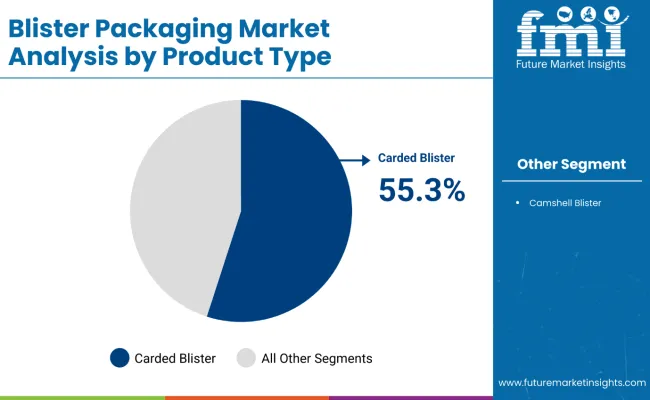
Thermoformed segment is estimated to account for 64% of the blister packaging market share in 2025. The segment's leading position stems from its fundamental role as a critical component in pharmaceutical packaging applications and its extensive use across multiple medication categories. Thermoformed blister's dominance is attributed to its superior cost-effectiveness, including rapid production speeds, material efficiency, and tooling flexibility that make it indispensable for high-volume pharmaceutical operations.
Market Position: Thermoformed systems command the leading position in the blister packaging market through advanced manufacturing features, including comprehensive format options, transparent product visibility, and reliable sealing capabilities that enable pharmaceutical companies to deploy unit-dose solutions across diverse medication portfolios.
Value Drivers: The segment benefits from pharmaceutical preference for proven packaging technology that provides adequate barrier protection without requiring exotic materials. Efficient production processes enable deployment in generic drug packaging, over-the-counter medication, and prescription applications where cost-effectiveness and manufacturing speed represent critical supply chain requirements.
Competitive Advantages: Thermoformed systems differentiate through excellent design flexibility, proven sealing performance, and compatibility with high-speed pharmaceutical packaging lines that enhance medication protection while maintaining economical operational profiles suitable for diverse dosage applications.
Key market characteristics:
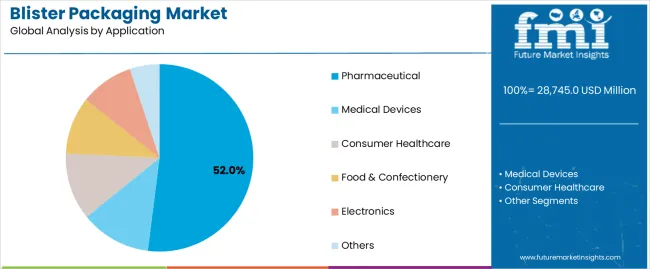
Pharmaceutical segment is projected to hold 52% of the blister packaging market share in 2025. The segment's market leadership is driven by the extensive use of blister packaging in prescription medications, generic drugs, clinical trial supplies, and specialty pharmaceuticals, where packaging serves as both a protective barrier and dose identification system. The pharmaceutical industry's consistent investment in compliant packaging materials supports the segment's dominant position.
Market Context: Pharmaceutical applications dominate the market due to widespread adoption of unit-dose packaging materials and increasing focus on medication adherence management, product authentication, and regulatory compliance applications that enhance patient safety while maintaining drug stability.
Appeal Factors: Pharmaceutical companies prioritize packaging integrity, tamper-evidence features, and integration with serialization strategies that enable coordinated deployment across multiple distribution channels. The segment benefits from substantial quality control investments and stringent regulatory requirements that emphasize protective packaging for prescription and controlled substance operations.
Growth Drivers: Generic drug manufacturing programs incorporate blister packaging as standard format for tablet and capsule medications. At the same time, specialty pharmaceutical initiatives are increasing demand for high-barrier systems that comply with stability requirements and enhance patient compliance.
Market Challenges: Material certification timelines and validation requirements may limit deployment flexibility in rapid drug launch scenarios or reformulation projects.
Application dynamics include:
Growth Accelerators: Generic pharmaceutical expansion drives primary adoption as blister packaging systems provide cost-effective dose protection that enables medication affordability without compromising patient safety, supporting healthcare access and regulatory compliance that require individual unit identification. Aging population demographics accelerate market expansion as chronic disease management creates demand for medication packaging solutions that enhance adherence through organized dose presentation and reminder capabilities. Regulatory enforcement increases worldwide, creating ongoing requirements for tamper-evident systems that protect medication integrity and provide chain-of-custody documentation in controlled pharmaceutical distribution environments.
Growth Inhibitors: Tooling investment challenges vary across pharmaceutical segments regarding equipment costs and format development requirements, which may limit market penetration and manufacturing flexibility in small-volume specialty categories with moderate production quantities. Material compatibility constraints persist regarding drug-packaging interactions and moisture transmission rates that may increase validation timelines in sensitive pharmaceutical applications with demanding stability standards. Market fragmentation across multiple blister formats and sealing specifications creates standardization concerns between different packaging suppliers and existing pharmaceutical infrastructure.
Market Evolution Patterns: Adoption accelerates in generic drug and consumer healthcare sectors where unit-dose presentation justifies material costs, with geographic concentration in pharmaceutical manufacturing hubs transitioning toward mainstream adoption in emerging markets driven by healthcare infrastructure development and medication access programs. Technology development focuses on enhanced barrier capabilities, improved child-resistance mechanisms, and integration with digital tracking platforms that optimize medication management and regulatory compliance. The market could face disruption if alternative unit-dose formats or dispensing innovations significantly challenge blister packaging advantages in pharmaceutical applications.
The blister packaging market demonstrates varied regional dynamics with Growth Leaders including India (6.9% CAGR) and China (6.4% CAGR) driving expansion through pharmaceutical manufacturing growth and generic drug production. Steady Performers encompass the USA (5.8% CAGR), Germany (5.4% CAGR), and the UK (5.2% CAGR), benefiting from established pharmaceutical sectors and specialty medication packaging adoption.
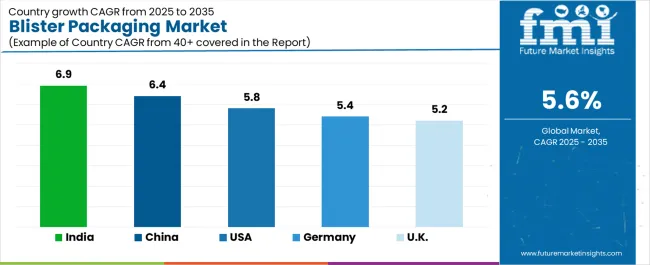
| Country | CAGR (2025-2035) |
|---|---|
| India | 6.9% |
| China | 6.4% |
| USA | 5.8% |
| Germany | 5.4% |
| UK | 5.2% |
Regional synthesis reveals Asia-Pacific markets leading growth through pharmaceutical manufacturing expansion and generic drug production development, while European countries maintain steady expansion supported by specialty pharmaceutical packaging and regulatory compliance requirements. North American markets show strong growth driven by prescription medication volume and patient compliance initiatives.
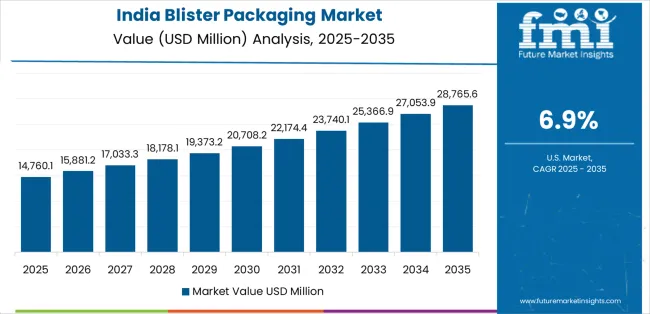
India establishes regional leadership through explosive generic pharmaceutical production and comprehensive medication export development, integrating advanced blister packaging systems as standard components in tablet packaging and prescription drug applications. The country's 6.9% CAGR through 2035 reflects government initiatives promoting pharmaceutical manufacturing excellence and generic drug accessibility that mandate the use of compliant packaging systems in domestic and export operations. Growth concentrates in pharmaceutical clusters, including Hyderabad, Ahmedabad, and Baddi, where contract manufacturing expansion showcases integrated blister packaging systems that appeal to international pharmaceutical companies seeking cost-effective production and established quality standards.
Indian manufacturers are developing innovative blister packaging solutions that combine local production cost advantages with international pharmaceutical standards, including high-speed thermoforming systems and advanced barrier film capabilities.
Strategic Market Indicators:
The Chinese market emphasizes pharmaceutical infrastructure modernization, including rapid healthcare reform implementation and comprehensive medication access programs that increasingly incorporate blister packaging for prescription drug distribution and patient compliance applications. The country is projected to show a 6.4% CAGR through 2035, driven by massive healthcare expenditure increases under government reform programs and commercial demand for compliant, high-quality packaging systems. Chinese pharmaceutical facilities prioritize production efficiency with blister packaging delivering cost-effective unit-dose protection through automated manufacturing lines and material optimization capabilities.
Technology deployment channels include domestic pharmaceutical manufacturers, international drug companies with Chinese operations, and contract packaging facilities that support localized production for regional markets.
Performance Metrics:
The USA market emphasizes advanced blister packaging features, including innovative compliance packaging designs and integration with comprehensive pharmacy dispensing systems that manage medication adherence, dose tracking, and patient safety applications through unified packaging solutions. The country is projected to show a 5.8% CAGR through 2035, driven by specialty pharmaceutical launches under chronic disease management programs and commercial demand for tamper-evident, child-resistant packaging systems. American pharmaceutical companies prioritize patient compliance with blister packaging delivering organized medication schedules through calendar formats and reminder integration capabilities.
Technology deployment channels include major pharmaceutical manufacturers, contract packaging organizations, and pharmacy automation systems that support prescription fulfillment for retail operations.
Performance Metrics:
The German market demonstrates growth with a 5.4% CAGR through 2035, driven by pharmaceutical innovation programs and specialized medication investments that emphasize high-barrier packaging systems for biotechnology and specialty drug applications. In Frankfurt, Munich, and Hamburg, German pharmaceutical companies and contract manufacturers are implementing advanced blister packaging systems to enhance medication protection capabilities and support regulatory compliance that aligns with European pharmaceutical standards and quality protocols. German pharmaceutical facilities are prioritizing blister systems that provide exceptional barrier performance while maintaining compliance with serialization mandates and minimizing counterfeiting vulnerabilities, particularly important in prescription medication and controlled substance operations. Market expansion benefits from pharmaceutical excellence programs that mandate protective packaging in drug approval specifications, creating demand across Germany's pharmaceutical manufacturing sectors, where product integrity and traceability represent critical requirements.
Strategic Market Indicators:
The UK's established pharmaceutical market demonstrates strategic blister deployment, growing at 5.2% CAGR, with documented operational integration in prescription dispensing and patient compliance programs through coordination with National Health Service systems and pharmacy infrastructure. The country leverages healthcare expertise in medication management and quality assurance to maintain market leadership. Pharmaceutical centers, including London, Cambridge, and Manchester, showcase packaging installations where blister systems integrate with comprehensive dispensing platforms and inventory control systems to optimize medication adherence and patient outcomes.
British pharmaceutical operations prioritize packaging compliance and patient accessibility in medication delivery development, creating demand for versatile blister systems with advanced features, including calendar packaging formats and integration with repeat prescription protocols. The market benefits from established pharmaceutical infrastructure and willingness to invest in compliance packaging technologies that provide superior medication management and regulatory alignment.
Market Intelligence Brief:
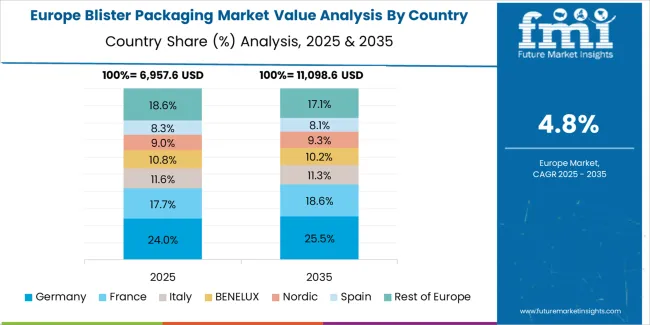
The blister packaging market in Europe is projected to grow from USD 8,937 million in 2025 to USD 14,826 million by 2035, registering a CAGR of 5.2% over the forecast period. Germany is expected to maintain its leadership position with a 31.4% market share in 2025, reaching 32.1% by 2035, supported by its pharmaceutical manufacturing excellence and specialty medication focus, including operations in Frankfurt, Munich, and the Rhine Valley region.
The United Kingdom follows with a 24.7% share in 2025, projected to reach 24.3% by 2035, driven by comprehensive NHS prescription programs and pharmacy compliance packaging initiatives. France holds a 19.6% share in 2025, expected to maintain 19.8% by 2035 through established pharmaceutical sectors and generic drug production. Italy commands a 13.2% share, while Spain accounts for 8.7% in 2025. The Rest of Europe region is anticipated to gain momentum, expanding its collective share from 2.4% to 2.9% by 2035, attributed to increasing pharmaceutical manufacturing in Poland, Hungary, and other Eastern European countries implementing modern packaging facilities and export-oriented production programs.
The blister packaging market operates with moderate concentration, featuring approximately 22-30 participants, where leading companies control roughly 38-44% of the global market share through established pharmaceutical relationships and comprehensive barrier technology capabilities. Competition emphasizes material innovation, production efficiency, and regulatory compliance rather than price-based rivalry.
Market leaders encompass Amcor plc, Constantia Flexibles, and Klöckner Pentaplast, which maintain competitive advantages through extensive barrier film expertise, global manufacturing networks, and comprehensive pharmaceutical validation capabilities that create customer loyalty and support quality-based differentiation. These companies leverage decades of pharmaceutical packaging experience and ongoing material science investments to develop advanced blister systems with exceptional protection and compliance features.
Technology specialists include Tekni-Plex Inc., Bemis Company Inc., and Bilcare Limited, which compete through specialized cold-form technology focus and innovative child-resistant solutions that appeal to pharmaceutical companies seeking high-barrier capabilities and regulatory certification efficiency. These companies differentiate through material science emphasis and specialized pharmaceutical application focus.
Market dynamics favor participants that combine reliable barrier performance with comprehensive regulatory support, including validation documentation and stability testing capabilities. Competitive pressure intensifies as traditional flexible packaging manufacturers expand into pharmaceutical blister systems. At the same time, specialized medical packaging companies challenge established players through innovative smart packaging solutions and cost-effective manufacturing targeting generic pharmaceutical segments.
| Item | Value |
|---|---|
| Quantitative Units | USD 28,745 million |
| Product Type | Thermoformed, Cold-Form, Others |
| Application | Pharmaceutical, Medical Devices, Consumer Healthcare, Food & Confectionery, Electronics, Others |
| Regions Covered | North America, Europe, Asia Pacific, Latin America, Middle East & Africa |
| Countries Covered | USA, Germany, UK, China, India, and 25+ additional countries |
| Key Companies Profiled | Amcor plc, Constantia Flexibles, Klöckner Pentaplast, Tekni-Plex Inc., Bemis Company Inc., Bilcare Limited |
| Additional Attributes | Dollar sales by product type and application categories, regional adoption trends across North America, Europe, and Asia-Pacific, competitive landscape with pharmaceutical packaging manufacturers and specialty material suppliers, pharmaceutical preferences for barrier protection and compliance features, integration with track-and-trace systems and pharmacy automation, innovations in child-resistant technology and smart packaging, and development of high-barrier material solutions with enhanced moisture protection and medication stability capabilities |
The global blister packaging market is estimated to be valued at USD 28,745.0 million in 2025.
The market size for the blister packaging market is projected to reach USD 49,568.0 million by 2035.
The blister packaging market is expected to grow at a 5.6% CAGR between 2025 and 2035.
The key product types in blister packaging market are thermoformed, cold-form and others.
In terms of application, pharmaceutical segment to command 52.0% share in the blister packaging market in 2025.






Full Research Suite comprises of:
Market outlook & trends analysis
Interviews & case studies
Strategic recommendations
Vendor profiles & capabilities analysis
5-year forecasts
8 regions and 60+ country-level data splits
Market segment data splits
12 months of continuous data updates
DELIVERED AS:
PDF EXCEL ONLINE
Competitive Overview of Blister Packaging Companies
USA Blister Packaging Market Trends – Demand & Growth 2025-2035
Japan Blister Packaging Market Trends – Demand & Growth 2025-2035
Pharma Blister Packaging Machines Market Size and Share Forecast Outlook 2025 to 2035
Competitive Overview of Pharma Blister Packaging Machines Industry Share
Leading Providers & Market Share in Pharma Blister Packaging
Carded Blister Packaging Market
Sliding Blister Packaging Market Size and Share Forecast Outlook 2025 to 2035
Alu Alu Blister Packaging Machine Market Insights - Trends & Forecast 2025 to 2035
Understanding Market Share Trends in Alu-Alu Blister Packaging Machines
Germany Blister Packaging Market Size – Demand & Growth 2025-2035
High Barrier Pharmaceutical Packaging Films for Blister Market Size and Share Forecast Outlook 2025 to 2035
Blister Card Market Analysis by Product Type, Technology Type, Material Type, End-use Industry, and Region Forecast Through 2035
Blister Paper Market
Deblistering Machines Market Size and Share Forecast Outlook 2025 to 2035
Market Share Breakdown of Leading Deblistering Machine Providers
PVC Blister Packs Market
Welded Blisters Market Size and Share Forecast Outlook 2025 to 2035
Global Medicine Blister Market Analysis – Growth & Forecast 2025 to 2035
Holographic Blister Foil Market Size and Share Forecast Outlook 2025 to 2035

Thank you!
You will receive an email from our Business Development Manager. Please be sure to check your SPAM/JUNK folder too.
Chat With
MaRIA